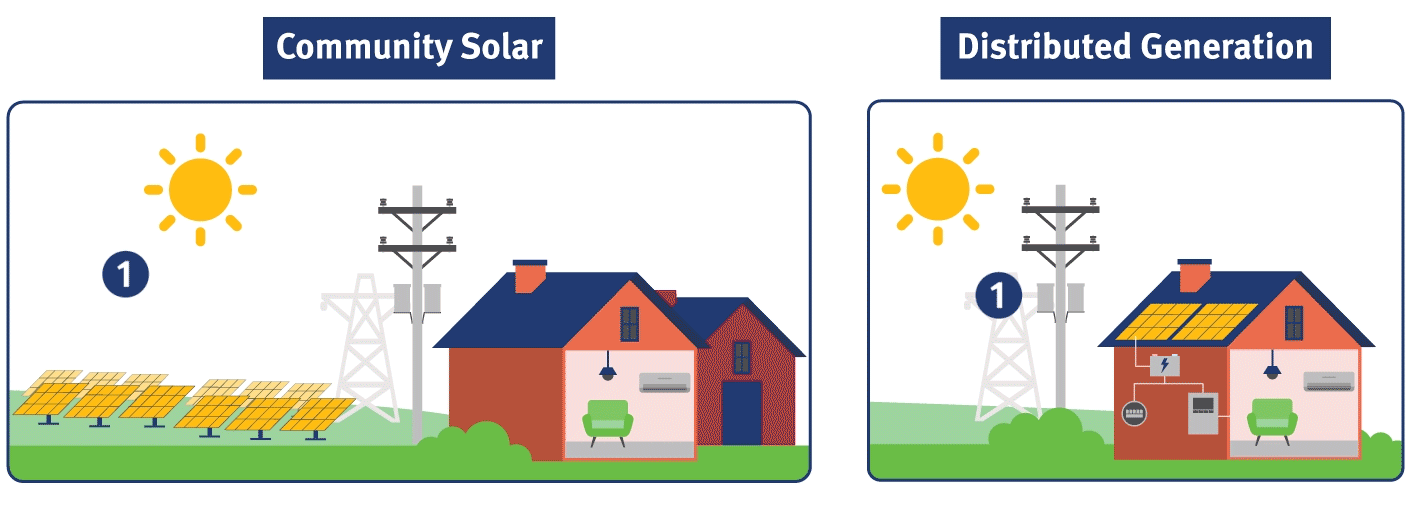Solar and Shines Basics
How Does Solar Work?
Solar power is produced when photovoltaic (PV) solar panels create energy from sunlight. Panels are installed and positioned to capture sunlight, which is absorbed by PV cells and generates electrical charges to create electricity. A group of solar panels, or array, can be connected in different sizes to help meet the electric needs of individual buildings, or communities of subscribers for larger solar arrays.
Electricity generated from solar panels can be used immediately (and/or stored on-site with batteries) as with Distributed Generation, or generated remotely and transmitted to the electrical grid, as with Community Solar projects.
In either model, the electricity produced helps reduce reliance on fossil fuel power plants. Solar power is a source of clean, abundant, and renewable energy.
The System Design Best Practices and Considerations page provides additional technical information.
- Solar panels (on-site with DG, or remotely with CS) create energy from sunlight.
- With DG, an inverter turns the electricity into alternating current. With CS, electricity is sent to the grid and then to your home.
- Clean, renewable solar energy helps power your home! On-site solar can be stored with a battery and even returned to the grid.

How Do Illinois Shines Incentives Work?
Illinois Shines provides incentives for solar projects through the purchase of Renewable Energy Credits, or RECs, from Distributed Generation and Community Solar projects. RECs are widely used in energy markets and represent the environmental value of energy generated by renewable sources, including solar. With RECs, the amount of renewable energy sent to the utility grid is tracked, and a REC is issued when one megawatt-hour of electricity from a renewable energy source is produced. Illinois Shines has set incentive amounts that are paid for RECs produced by solar projects participating in the Program. The incentives are paid to participating Approved Vendors and savings are passed on to customers.
Approved Vendors are entities approved by the Program Administrator (as an agent of the Illinois Power Agency), to submit project applications to the Illinois Shines Program and act as a counterparty to the Illinois Shines contracts with utilities. Designees are third parties (i.e., non-Approved Vendor) entities that have direct interaction with end-use customers; they include installers, marketing firms, lead generators, and sales organizations. Approved Vendors often work with Designees to manage various portions of solar system development.
How does a customer participating in Illinois Shines see savings from REC incentives?

Watch this video to learn more about what a REC is.
Illinois residents interested in solar power don’t have to participate in Illinois Shines and can work directly with installers to develop projects outside of the program. But Illinois Shines offers several key benefits for both customers and participating Approved Vendors. The Illinois Shines program:
- Brings costs for solar installations down through incentives
- Brings cost of energy down for subscribers to Community Solar projects
- Develops a diverse and inclusive workforce through the requirements of the Climate and Equitable Jobs Act, such as the requirement of the payment of prevailing wage to project installers and equity requirements for the companies that operate as Approved Vendors and Designees in the Program.
- Offers consumer protection through a project approval process that requires project and cost disclosures to be made to customers prior to contracting, and provides consumer protection resources, including a hotline and online form, to accept consumer inquiries and to investigate and resolve complaints, as well as the maintenance of vendor and designee complaint and disciplinary action reports
- Vets and approves Approved Vendors and Designees that participate in the Program
Illinois Shines Project Types
Illinois Shines supports solar energy across two main project types:
- Distributed Generation: Solar panels installed directly on the roof or land of a home, school, house of worship, business or other customer site.
- Community Solar: A large, centralized solar project providing solar bill credits to subscribers who don’t have access to their own solar panels. This is a great option for renters or homeowners for whom installing solar panels isn’t practical or cost-effective.
Across these project types, Illinois Shines currently supports six project categories:

Small Distributed Generation

Large Distributed Generation

Traditional Community solar

Community-driven community solar

Public schools

